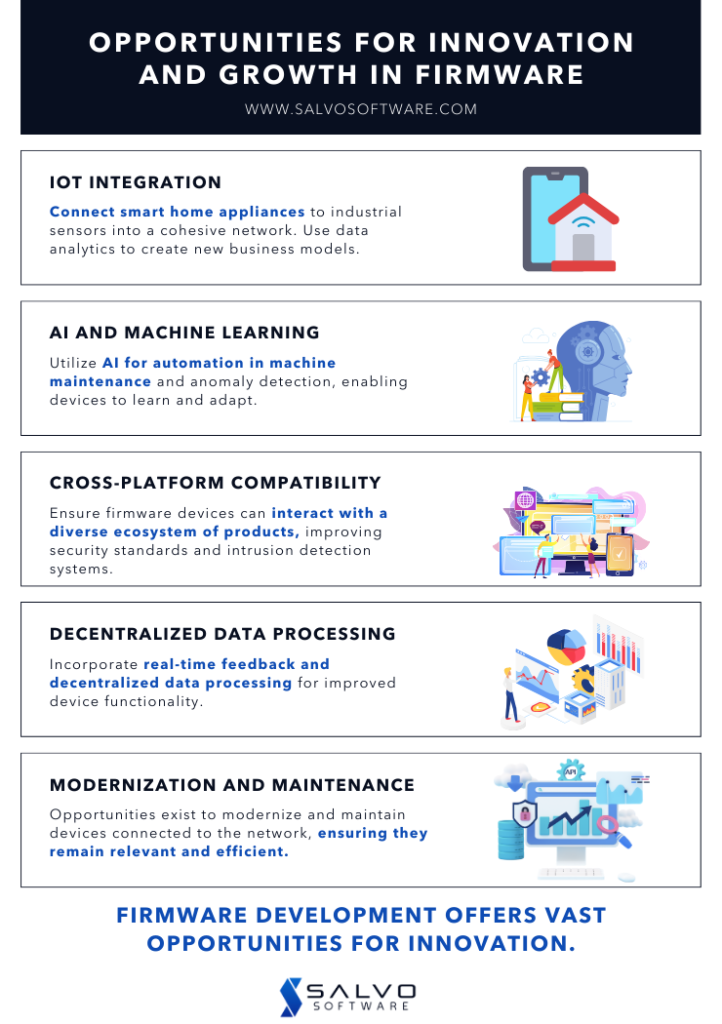Navigating the Future: Emerging Technologies and Innovations in Firmware Solutions
Firmware can seem invisible, but it just about runs the world. From the IoT (Internet of Things) sensors in our smart appliances, to satellites hanging in the night sky, its firmware solutions are a big part of what makes our futuristic world possible. But what’s the future of firmware?
Predicting the evolution of new technology is hard. Nobody has a crystal ball to help them see emerging technologies coming. Nevertheless, there are some fairly safe predictions you can make. Understanding what’s coming with a little insight into future trends, you can take those safe predictions and put them into practical use right now.

Emerging Technologies in Practice – Tesla’s Success
Tesla faces many of the same problems as everyone else. Times change. New technologies emerge and existing standards fall out of favor. However, because of their mastery over emerging firmware tech, Tesla has remained on the cutting edge of its industry.
Firmware is a special type of software that provides instructions to hardware components, as well as communicating with the user-facing software on a device. As the lynchpin that holds together any smart device, Tesla’s innovative use of firmware is a fantastic example of what can be achieved with a little creativity.
Adding lane-keeping assistance and adaptive cruise control, Tesla has improved on the core autonomous driving features that draw people to their brand. But that was just the beginning.
On the infotainment front, Tesla put more games in its car. They added a well-received light show feature and even customizable lock sounds. From a total revamp of all their wireless connectivity menus to a new calendar app, almost every part of their vehicles has been improved with the insights gained by collecting and analyzing user data.
The onslaught of updates continues to this day: automatic 911 support, auto-wiping in wet weather, and even a calculator to track the mileage of your tires. And what makes all this possible is its creative use of Over-The-Air (OTA) firmware updates.
From incremental improvements in performance to the introduction of totally new features, OTA helped Tesla to take existing devices and make them do new, incredible things. All without being returned to a service center.
The results speak for themselves. Capitalizing on emerging technologies, Tesla’s vehicles are safer, more efficient, and more capable than when they were driven off the lot. They’re not falling behind competitors because they’re leading the charge with the application of next-gen firmware solutions.

Firmware Solutions FAQ
What emerging technologies will have the most significant influence on future firmware solutions?
Machine learning is making firmware smarter and more efficient in ways we never thought possible. With the experienced application of machine learning, it’s possible to analyze the behavior of complex systems and discover new avenues for unforeseeable improvement. Firmware and Machine Learning will develop hand-in-hand.
Cybersecurity is improving in the same way. With emerging technologies like secure boot, people are starting to enjoy historically unparalleled protection. When only trusted firmware is allowed to load on boot, there are far fewer avenues of attack. Combined with hardware security features like TPMs (Trusted Platform Module), which are computer chips for storing authentication data, firmware solutions are poised to become even more potent.
With so many future trends on the horizon, these steps may only be the beginning. The decentralized processing advantages of edge computing mean that shortly, firmware may be doing far more impressive things on far less impressive hardware. The same can be said for the eventual arrival of quantum computing
How will firmware development adapt and evolve to new tech and industry trends?
Tech landscapes are always changing. Today we’re leveraging 5G networks to make the most of IoT (Internet of Things) devices, tomorrow we may be trying to integrate features with quantum computing. But whatever comes down the pipe, firmware needs to be ready to adapt.
And firmware development processes will adapt in much the same way as the broader software industry has adapted. By becoming more agile and iterative, firmware development can deliver faster updates, shorter development cycles, and the capacity to keep up with market trends.
Firmware developers are likely to start preferring more modular design. That can help facilitate the recycling of code, the extension of scalability, and the allowance of much easier maintenance. Over-the-air update capabilities are becoming a more important part of a product’s lifecycle.
Testing and analysis allow developers to identify vulnerabilities and bottlenecks earlier in the development lifecycle. Automating that process will likely become more important. Apart from obvious practical reasons for preferring automation, there’s also the fact that industry trends could accelerate as AI extends developer capabilities.
What potential challenges arise when integrating firmware in next-generation devices? How can they be addressed?
New devices may mean new hardware components, new architecture, or a new interface. They can also have greater or fewer resources, ranging from processing speed to energy consumption. Existing firmware solutions can either be prepared to adapt to that kind of ongoing innovation, or entire systems can become obsolete overnight.
Another significant challenge is security. Next-generation devices can be an ideal target for security breaches. Some of the earliest smart watches were breachable by simply sending them a text. In the past, that’s been addressed primarily with ongoing support. Next-generation firmware solutions may be able to automate that support so well that those problems can be eliminated in the crib.
Integrating firmware with next-gen devices can be extra challenging in environments with regulatory compliance concerns. When penetration testing fails to detect every avenue of attack, it isn’t long before you read headlines about hospitals paying millions of dollars to recover patient data locked behind ransomware.
The solutions to these kinds of problems can be just as unique as the problems themselves. Increasingly complex firmware features can be supported with better modular design, scalability, and maintainability. Firmware security needs to be a priority to assess vulnerabilities and test to mitigate them continually.
Continual collaboration and prototyping can solve many of these problems, but streamlined development and maintenance is the best way to address most of these issues.
Where are opportunities for innovation and growth in the firmware? How can they be capitalized?
In the near term, some of the most exciting opportunities for firmware development are in IoT devices. With a little creativity, businesses can connect everything from smart home appliances to industrial sensors into one cohesive network. Combining data analytics with IoT networks, it’s now possible to create business models that could only have emerged recently.
Another near-term possibility involves leveraging AI and machine learning to open possibilities for automation. From machine maintenance to the detection of anomalies, AI models make it possible for firmware devices to learn and adapt to changing conditions. (Not unlike all the wonderfully successful work Tesla has been doing.)
As firmware devices are increasingly likely to interact with a diverse ecosystem of products, cross-platform compatibility is another avenue for innovation. For example, security and cybersecurity can reach higher standards than ever before in the development of vastly superior intrusion detection systems.
Whether you want to take advantage of decentralized data processing and incorporate real-time feedback, or you’re just looking to modernize and maintain devices connected to the network, developers are facing a wealth of new opportunities for innovation and growth.
If you’d like to explore these opportunities for your own projects, what you need most of all are experienced development services that can adapt to the scope of your project.

How can stakeholders prepare for the future of firmware solutions?
In a rapidly evolving tech landscape, success requires making the right investments. That could mean investing in emerging tech trends with research & development to develop new services or improve existing ones. It could mean obtaining the right talent, and it could mean investing in a culture of innovation.
But there are some basic things that everyone should be doing. For example, industry leaders should stay in touch with emerging trends. What are your industry leaders and closest competitors doing with AI? How are they using the IoT or edge computing? From drycleaners using smart garment tracking to big box retailers streamlining logistics, there’s a wealth of creative work in firmware being done right now.
Another piece of low-hanging fruit is taking advantage of the shared resources available through open-source development. Combined with creating strategic alliances with key players in the tech space, it’s much easier to share, acquire, and use expertise with new tech. Companies like Samsung, Intel, Sony, Apple, and Microsoft have excelled at this… but the same things can be done with smaller organizations.
Above all – you can future-proof operations. With iterative development, modular design, and standardization, firmware can be made scalable and adaptable enough to prepare you for even the unforeseeable future. With a deft hand, thoughtful preparation, and the right partnerships, you can be ready for emerging ecosystems before they even exist.
Firmware Solutions in Practice
If you need guidance navigating firmware, start your search with Salvo. Our custom software solutions know how to deliver the benefits of emerging technologies at a price that makes sense for your project.


 The Ultimate Guide to Business Automation: What is It, Why is it Important, How Does it Work?
The Ultimate Guide to Business Automation: What is It, Why is it Important, How Does it Work?  Internet of Things (IoT): A Beginner’s Guide
Internet of Things (IoT): A Beginner’s Guide  ERP Systems: Everything You Need to Know
ERP Systems: Everything You Need to Know  Crafting Exceptional Experiences: Harnessing Design Thinking for UI/UX Problem Solving
Crafting Exceptional Experiences: Harnessing Design Thinking for UI/UX Problem Solving  Unlocking Knowledge: Navigating the Future of Education with AI in Learning Applications
Unlocking Knowledge: Navigating the Future of Education with AI in Learning Applications